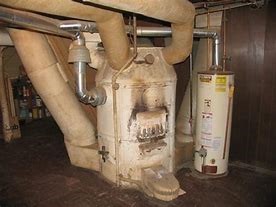 Although it does not happen very frequently, every once in a while, I run into an old gravity-based furnace when completing a home inspection. These furnaces are also referred to “Octopus” furnaces, because of how the ducting come out of the unit. They rely completely on the convection of the heat to spread throughout the ducts of the home. As you might guess, this type of heating system is very inefficient, especially compared to the heating systems of today. The requirement of all furnaces today is to be at least 78% efficient, and many units are high-efficiency, producing up to 98% efficient combustion at the unit (this does not account for any heat loss in the ducting).
Although it does not happen very frequently, every once in a while, I run into an old gravity-based furnace when completing a home inspection. These furnaces are also referred to “Octopus” furnaces, because of how the ducting come out of the unit. They rely completely on the convection of the heat to spread throughout the ducts of the home. As you might guess, this type of heating system is very inefficient, especially compared to the heating systems of today. The requirement of all furnaces today is to be at least 78% efficient, and many units are high-efficiency, producing up to 98% efficient combustion at the unit (this does not account for any heat loss in the ducting).
So, what are the true concerns of an older gravity furnace heat system? The main concerns are:
- As already indicated, these systems are low-efficiency units, that are typically less than 78% efficient. This means it will cost more to heat the house versus a newer mid-efficient or high-efficient system.
- Newer systems have induction fans as part of the exhaust. This not only improves the efficiency but is less likely to have carbon monoxide spills into the furnace room/house.
- Exhaust systems for gravity-based furnaces can be single-wall vent pipes, which get much hotter than newer plastic or double-wall pipes and are more to have exhaust spillage. Sometimes this spillage will be dumped into a chimney and will not be taken all the way through the top of the chimney.
- As seen in the photo, many old gravity systems have tape or insulation that contains asbestos fibers. This is a health concern if the asbestos material becomes damaged, friable, and air-born.
- The cost of removing and replacing these gravity systems can be extensive. Between possible asbestos mitigation, as described above, typically the ducting and the exhaust pipes also need to be replaced with a new system. Replacing these systems, even with a mid-efficiency system, is well beyond the cost of replacing a mid-efficient system with another mid-efficient system.
The end take-away from this is simple – if you or your client is looking at purchasing an older home that contains a heating system that looks like an octopus, be wary of the safety concerns and long-term costs associated with just updating this system!
